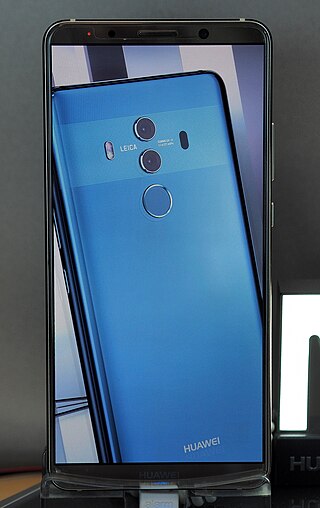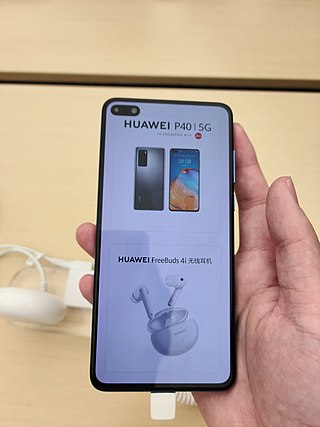
A smartphone is a portable computer device that combines mobile telephone functions and personal computing functions into one unit. They are distinguished from older-design feature phones by their more advanced hardware capabilities and extensive mobile operating systems, which facilitate wider software, access to the internet, and multimedia functionality, alongside core phone functions such as voice calls and text messaging. Smartphones typically contain a number of metal–oxide–semiconductor (MOS) integrated circuit (IC) chips, include various sensors that can be leveraged by pre-installed and third-party software, and support wireless communication protocols. More recently, smartphone manufacturers have begun to integrate satellite messaging connectivity and satellite emergency services into devices for use in remote regions where there is no reliable cellular network.

A camera phone is a mobile phone which is able to capture photographs and often record video using one or more built-in digital cameras. It can also send the resulting image wirelessly and conveniently. The first commercial phone with color camera was the Kyocera Visual Phone VP-210, released in Japan in May 1999.

The Samsung Galaxy S series is a line of flagship Android smartphone and tablet computer produced by Samsung Electronics. In conjunction with the foldable Galaxy Z series, the lineup serves as Samsung's flagship smartphone lineup.

The Samsung Galaxy S4 Zoom is a phone with camera hybrid with a 10x optical zoom with f/3.1-6.3 lens with built-in optical image stabilizer and a standard xenon flash. It was introduced in July 2013.

Nexus 6P is an Android smartphone developed and marketed by Google and manufactured by Huawei. It succeeded the Nexus 6 as the flagship device of the Nexus line of Android devices by Google. Officially unveiled on 29 September 2015 along with the Nexus 5X at the Google Nexus 2015 press event held in San Francisco, it was made available for pre-order on the same day in United States, United Kingdom, Ireland, and Japan.
DXOMARK is a commercial website described as "an independent benchmark that scientifically assesses smartphones, lenses and cameras". Founded in 2008, DxOMark was originally owned by DxO Labs, a French engineering and consulting company, which is headquartered in Boulogne-Billancourt, Paris, France. DXOMARK Image Labs was separated from DxO Labs in September 2017, and was later re-branded to DXOMARK in 2019. DXOMARK is now a wholly independent privately-owned company.
The Huawei Mate 9 is a high-end Android smartphone, designed and produced by Huawei as part of the Huawei Mate series. It was released on 3 November 2016. It was succeeded by the Huawei Mate 10 series, and later the Huawei Mate 20 series.

The Huawei P10 is an Android phablet smartphone manufactured by Huawei. Announced at Mobile World Congress 2017 on 26 February 2017, the P10 is the successor to the Huawei P9 and was succeeded by the Huawei P20 in 2018.

The Huawei Mate 10, Huawei Mate 10 Pro and Huawei Mate 10 Lite are Android smartphones designed and marketed by Huawei as part of the Huawei Mate series. There is also a Mate 10 Porsche design, which has 256Gb of storage but is otherwise identical to the Mate 10 Pro. They were first released on 16 October 2017. Versus the predecessor Mate 9, the Mate 10 pro flagship phone has a faster processor with an integrated neural processing unit, a slightly larger OLED screen (6.0") with a taller 18:9 aspect ratio, a significantly longer battery life and a glass back construction. Chinese and international models are available in dual SIM configuration. It comes with Android 8 and a newer version of Huawei's EMUI interface. All Mate 10 models are unlocked and GSM only. Huawei phones, including the Mate series, are not sold or financed through U.S. carriers due to pressure from U.S. intelligence agencies, though they are available from independent and online retailers.

The Samsung Galaxy S9 and S9+ are Android-based smartphones unveiled, manufactured, released and marketed by Samsung Electronics as part of the Samsung Galaxy S series. The devices were revealed at the Mobile World Congress in Barcelona on 25 February 2018, as the successors to the Samsung Galaxy S8 and S8+.

The Samsung Galaxy S10 is a line of Android-based smartphones manufactured, released and marketed by Samsung Electronics as part of the Samsung Galaxy S series. The Galaxy S10 series is the tenth generation of the Samsung Galaxy S, its flagship line of phones next to the Note models, which is also the 10th anniversary of the Galaxy S. Unveiled during the "Samsung Galaxy Unpacked 2019" press event held on 20 February 2019, the devices started shipping in certain regions such as Australia and the United States on 6 March 2019, then worldwide on 8 March 2019.

The Huawei P series is a line of high-end and medium-range HarmonyOS smartphones produced by Huawei. The P series was formerly marketed as part of Huawei's larger Ascend brand. Some models are called P smart.

Huawei Mate 20 is a line of Android phablets produced by Huawei, which collectively succeed the Mate 10 as part of the Huawei Mate series. The flagship models, the Mate 20 and Mate 20 Pro, were unveiled on 20 July 2018 at a press conference in London.
The Samsung Galaxy A9 (2018) is a midrange Android smartphone produced by Samsung Electronics as part of the Samsung Galaxy A series. It was announced on 11 October 2018 at the A Galaxy event in Kuala Lumpur, Malaysia, as the successor to the Samsung Galaxy A9 (2016). Galaxy A9 (2018) is the world's first smartphone that features 4 different cameras on the rear. It features a 6.3 inch Super AMOLED Infinity Display with curved edges similar to the Samsung Galaxy A8 (2018) and supports Dolby Atmos immersive sound technology. It is the brand ambassador for Ayushmann Khurrana. It is the predecessor of Samsung Galaxy A70.

Huawei P30 is a line of Android-based smartphones manufactured by Huawei. Unveiled on 26 March 2019, they succeed the Huawei P20 in the company's P series line.

The Honor 8x is a smartphone made by Huawei under their Honor sub-brand. It is a successor of the Huawei Honor 7x within the Huawei Honor series.

Huawei Mate 30 is a line of Android-based phablets manufactured by Huawei as part of its Huawei Mate series, and the successor to the Mate 20. The Mate 30 comprises the Mate 30/5G, Mate 30 Pro/5G, and Mate 30 RS Porsche Design, which were unveiled on 19 September 2019 in Munich, Germany.

Huawei P40 is a line of high-end Android-based smartphones manufactured by Huawei. Unveiled on 26 March 2020, they succeed the Huawei P30 in the company's P series line.

The Huawei P50 and P50 Pro are HarmonyOS-based high-end smartphones manufactured by Huawei. Unveiled on 21 July 2021, they succeed the Huawei P40 in the P series. In March 2023 Huawei released their successor Huawei P60 Series phones in China, and in May 2023 it released the Huawei P60 Pro in Europe.
















